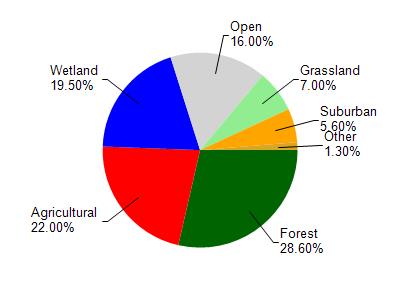Shawano
No
No
Yes
Fish and Aquatic Life
Overview
Mud Lake is a hard water drainage lake having slightly alkaline, light brown water of low to moderate transparency. The entire littoral zone is composed of muck. The entire shoreline is a marsh wetland. Due to its shallow depth and dense growth of floating and submergent vegetation, winterkill may occur limiting the fishery of forage species. The lake is of value to spawning northern pike which came from Shawano Lake via Pickerel Creek. The lake is of important value to nesting and migratory waterfowl. Canada, blue and snow geese and swan also utilize this area on their migrations. Due to its waterfowl value the adjoining land areas have been purchased by the country and designated as the Mud Lake Wildlife Area. Public access of the wilderness type over county land is available. There are no developments located on the shoreline. The outlet stream, Pickerel Creek, is tributary to Shawano Lake.
Source: 1968, Surface Water Resources of Shawano County Mud Lake, T27N, R17E, Section 21 Surface Acres = 33.8, S.D.F. = 1.84, Maximum Depth = 2 feet.
Date 1968
Author Aquatic Biologist
Impaired Waters
Mud Lake (WBIC 326000) was assessed during the 2018 listing cycle; total phosphorus sample data clearly exceeded the 2018 WisCALM listing thresholds for the Recreation use and Fish and Aquatic Life use. Chlorophyll-a sample data did not exceed the REC or FAL use thresholds. This lake was proposed for total phosphorus listing in 2018.
Date 2017
Author Ashley Beranek
Condition
Wisconsin has over 84,000 miles of streams, 15,000 lakes and milllions of acres of wetlands. Assessing the condition of this vast amount of water is challenging. The state's water monitoring program uses a media-based, cross-program approach to analyze water condition. An updated monitoring strategy (2015-2020) is now available. Compliance with Clean Water Act fishable, swimmable standards are located in the Executive Summary of Water Condition in 2018. See also the 'monitoring and projects' tab.
Reports
Management Goals
Wisconsin's Water Quality Standards provide qualitative and quantitative goals for waters that are protective of Fishable, Swimmable conditions [Learn more]. Waters that do not meet water quality standards are considered impaired and restoration actions are planned and carried out until the water is once again fishable and swimmable
Management goals can include creation or implementation of a Total Maximum Daily Load analysis, a Nine Key Element Plan, or other restoration work, education and outreach and more. If specific recommendations exist for this water, they will be displayed below online.
Monitoring
Monitoring the condition of a river, stream, or lake includes gathering physical, chemical, biological, and habitat data. Comprehensive studies often gather all these parameters in great detail, while lighter assessment events will involve sampling physical, chemical and biological data such as macroinvertebrates. Aquatic macroinvertebrates and fish communities integrate watershed or catchment condition, providing great insight into overall ecosystem health. Chemical and habitat parameters tell researchers more about human induced problems including contaminated runoff, point source dischargers, or habitat issues that foster or limit the potential of aquatic communities to thrive in a given area. Wisconsin's Water Monitoring Strategy was recenty updated.
Grants and Management Projects
| Project Name (Click for Details) | Year Started |
|---|
|
|
Monitoring Projects
| WBIC | Official Waterbody Name | Station ID | Station Name | Earliest Fieldwork Date | Latest Fieldwork Date | View Station | View Data |
|---|
| 326000 | Mud Lake | 10005736 | Mud Lake | 9/8/2000 | 7/23/2012 | Map | Data |
| 326000 | Mud Lake | 10039273 | Mud Lake- Deep Hole | 7/23/2013 | 1/1/2015 | Map | Data |
|

Watershed Characteristics
Mud Lake is located in the Shawano Lake watershed which is 71.16 mi². Land use in the watershed is primarily forest (28.60%), agricultural (22%) and a mix of wetland (19.50%) and other uses (29.90%). This watershed has 76.28 stream miles, 7,438.74 lake acres and 7,573.91 wetland acres.
Nonpoint Source Characteristics
This watershed is ranked Not Ranked for runoff impacts on streams, High for runoff impacts on lakes and High for runoff impacts on groundwater and therefore has an overall rank of High. This value can be used in ranking the watershed or individual waterbodies for grant funding under state and county programs.However, all waters are affected by diffuse pollutant sources regardless of initial water quality. Applications for specific runoff projects under state or county grant programs may be pursued. For more information, go to surface water program grants.